
Dairy Industry in North Africa: Challenges, Prospects, and the Path to Self-Sufficiency
Dairy Sector Crisis: Can North Africa Achieve Self-Reliance?
The dairy industry in North Africa stands at a critical juncture. As populations expand and governments push for self-sufficiency in dairy production, the region faces significant challenges: supply chain disruptions, processing inefficiencies, and climate-related obstacles.
Key Question: Can North Africa truly achieve self-sufficiency in dairy production, and what role does industrial efficiency play in this transformation?
Dairy Production in North Africa: The Comprehensive View
Food security has emerged as a top priority for North African countries in recent years. With projections indicating rapid population growth across the region—Egypt alone is expected to reach 120 million people by 2030—the need for stable, locally-produced dairy supplies has never been more critical.
However, achieving this goal presents numerous complexities. Seasonal shortages, outdated processing infrastructure, and inconsistent government policies continue to challenge dairy producers throughout the region.
Egypt: Growth Ambitions Amid Bottlenecks
Egypt is currently developing its first-ever dairy industry roadmap, aiming to increase dairy consumption from 61 kg to 70 kg per capita by 2030. While this approach appears promising, milk production remains fragmented, with 70% of raw milk sourced from small farms lacking modern cooling and storage solutions.
Primary Challenge: Seasonal fluctuations in milk production create instability in the supply chain, making efficient processing and packaging infrastructure essential for maintaining year-round product availability.
Algeria: Substantial Investments, Ambitious Goals
Algeria represents another country pursuing self-sufficiency, facing an annual milk deficit of 1.5 billion liters. A $3.5 billion agreement with Qatari firm Baladna Q.P.S.C. is expected to close this gap by adding 1.7 billion liters of milk annually to domestic production.
Primary Challenge: Large-scale dairy operations require robust industrial infrastructure, particularly in processing and distribution sectors, to prevent logistical bottlenecks that could undermine expansion efforts.
Morocco: From Dairy Exporter to Production Decline
Morocco once achieved self-sufficiency in dairy production but has since experienced a 25% reduction in output due to drought conditions and inefficiencies in milk processing. Numerous milk farms in key production regions have ceased operations, highlighting the vulnerability of the supply chain.
Primary Challenge: Growing reliance on imported dry milk is restructuring Morocco’s dairy industry, raising significant questions about the long-term sustainability of local dairy farming practices.
Tunisia: The Self-Sufficiency Paradox
Tunisia declared raw milk self-sufficiency in 1999, yet recent shortages have resulted in rationing measures, lengthy queues, and daily production deficits reaching 600,000 liters.
Primary Challenge: Since 2017, Tunisia has lost 25% of its dairy herd, making it increasingly difficult to meet local demand without comprehensive restructuring of dairy supply chains.
Future Prospects for Dairy Producers in North Africa
While each country confronts unique challenges, several common themes emerge across the region:
1️⃣ Supply Chain Optimization – Seasonal variations and climate challenges necessitate more efficient and resilient dairy production systems.
2️⃣ Infrastructure & Modernization – Processing, packaging, and storage solutions require urgent upgrades to ensure product quality and minimize waste.
3️⃣ Technology Investment – Automation and industrial efficiency solutions can significantly reduce production losses and stabilize supply chains throughout the year.
North Africa’s journey toward dairy self-sufficiency will be challenging, but companies investing in efficiency and reliability today will emerge as tomorrow’s industry leaders.
UAE: High-Tech Alternative to Dairy Self-Sufficiency
Unlike North Africa, where countries are working to enhance traditional dairy production efficiency, the United Arab Emirates (UAE) is pursuing an alternative approach.
By investing heavily in high-tech dairy farms and controlled environment agriculture, the UAE is working to partially reduce its import dependence. Companies like Al Rawabi and Al Ain Farms utilize advanced automated milking systems, climate-controlled barns, and hydroponic feed production to overcome the inherent challenges of dairy farming in arid climates.
However, despite these technological advancements, the UAE remains significantly dependent on dairy imports, as local production only satisfies a fraction of the country’s requirements. This highlights a fundamental contrast: while North Africa seeks to scale up traditional dairy farming practices, the UAE is betting on technology-driven solutions to ensure stable dairy supplies.